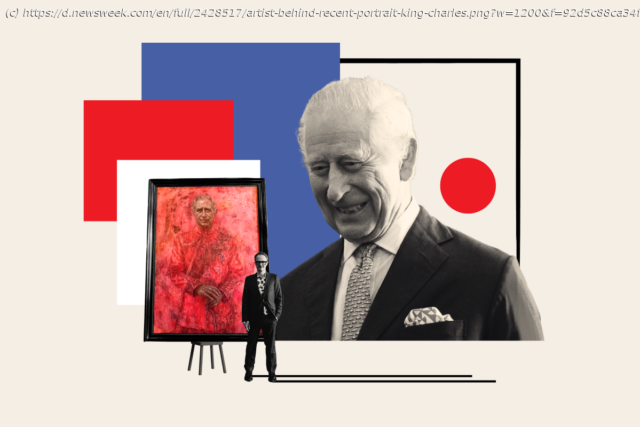When an eight-foot picture is shrunk down to the size of a phone screen, the portrait is oversimplified.
The day after my portrait’s public reveal with King Charles III—his first official painting since ascending to the throne—I saw that it was on the front cover of all the newspapers. That felt great, and those responses were all fairly positive.
Then it went mad online. It’s such an unusual thing for a painting to go so crazy around the world. But I soon became frustrated: The way the picture was reproduced tended to exaggerate the red color.
When an eight-foot picture is shrunk down to the size of a phone screen, the portrait is oversimplified, and this is the image most people see. A lot of people seemed to only be talking about the red. But the painting itself is a lot more subtle.
I’m on the board of the National Portrait Gallery in London and I was in a trustees meeting all afternoon so I couldn’t keep checking my phone. But I was occasionally getting messages from my daughters who were sending me the memes and conspiracy theories.
I thought this was perhaps a niche thing—until I saw these posts were getting millions of views.
It featured on Saturday Night Live and The Daily Show, Joe Rogan’s podcast and Alex Jones’s InfoWars, and chat shows everywhere—all these places you’d never expect a painted portrait to cut through to. It sparked so many conversations.
At that point, you feel like the painting no longer belongs to you.
Damien Hirst said to me many years ago that artists worry too much about avoiding bad reviews. What you want is both good and bad, because otherwise there’s no controversy for people to get excited about.
In our social media age, amid the TikTok phenomenon, I don’t underestimate the power of the 20 second video clip.
The video of the unveiling shows the picture under a theatrical black drape in the surroundings of the palace, and as the king pulls that off, he jumps out of the way because it’s massive and looking down from a height.
That tells a little ambiguous story. Whatever people were expecting of the painting—likely something more traditional—the reality probably wasn’t that, and the king’s reaction looked like surprise because he jumped back.
So, it invited everyone to interpret the portrait in the different ways they did. We obviously didn’t plan it like that, but in retrospect, I’m sure that’s partly why it cut through so far to the mainstream and the younger generation. It was a perfect little clip for sharing.
In truth, the king had seen the portrait when it was about 80 percent finished, so it wasn’t a complete surprise to him. I probably wouldn’t have been invited to do the public unveiling at the palace with him otherwise.
It’s an unusual picture, but I was trying to make it more contemporary and interesting, because royal portraits in recent decades have tended to be stiff and the faux-classical style has been a bit of a default.
But there’s no real reason for that. The few that diverge, like the one Lucian Freud did of Queen Elizabeth II, really stand out.
The king is really interested in painting, but I don’t think his mom was. To her it was an annoyance to sit for portraits, and it often showed in the pictures; she’s bearing it rather than enjoying it.
But Charles has a keen interest and is a big supporter of the arts. He set up the Royal Drawing School, which has become incredibly successful, and he paints himself.
I think the palace wouldn’t have asked me to do it unless he had some idea of my style already and knew what he was getting into.
I haven’t had any official feedback from the palace, but the king seemed very happy with the painting, and I have heard as much from others. The palace is probably more used than most to strange reactions, and so I think they took all the conspiracies in their stride.






